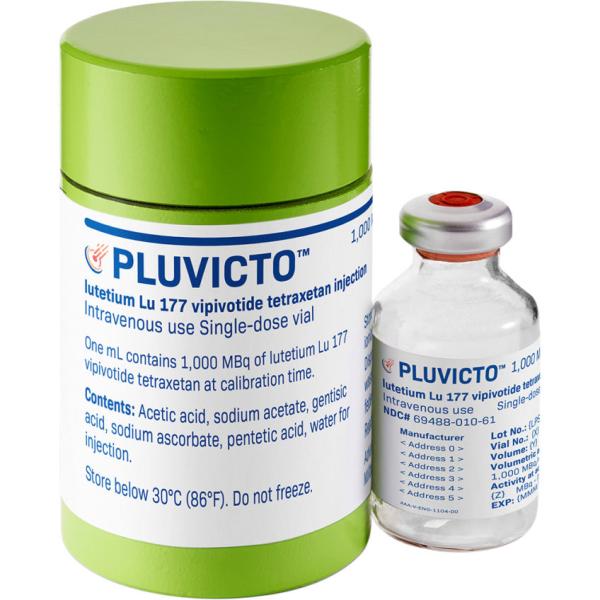Lutetium Lu 177 Vipivotide Tetraxetan Dosage
Applies to the following strengths: 1000 MBq/mL
Usual Adult Dose for:
Additional dosage information:
Usual Adult Dose for Prostate Cancer
7.4 GBq (200 mCi) IV every 6 weeks
Duration of therapy: Up to 6 doses, OR until disease progression or unacceptable toxicity
Comments:
- Locametz (gallium Ga 68 gozetotide) or another approved prostate-specific membrane antigen (PSMA)-11 imaging agent based on PSMA expression in tumors should be used to select patients with previously treated metastatic castration-resistant prostate cancer (mCRPC) for treatment with this drug; the manufacturer product information for the PSMA imaging agent should be consulted.
- Radiation Dosimetry: The maximum penetration in tissue is about 2 mm and the mean penetration is 0.67 mm.
- The manufacturer product information should be consulted for the estimated radiation absorbed doses to different organs.
Use: For the treatment of patients with PSMA-positive mCRPC who have been treated with androgen receptor pathway inhibition and taxane-based chemotherapy
Renal Dose Adjustments
Mild (baseline CrCl 60 to 89 mL/min [by Cockcroft-Gault]) or moderate (CrCl 30 to 59 mL/min) renal dysfunction: No adjustment recommended.
Severe (CrCl 15 to 29 mL/min) renal dysfunction or ESRD: Data not available
If renal toxicity develops during therapy:
- Confirmed serum creatinine increase (Grade 2 or higher): This drug should be withheld until improvement.
- Confirmed CrCl less than 30 mL/min (calculated using Cockcroft-Gault with actual body weight): This drug should be withheld until improvement.
- Confirmed 40% or greater increase from baseline serum creatinine AND confirmed greater than 40% decrease from baseline CrCl (calculated using Cockcroft-Gault with actual body weight): This drug should be withheld until improvement or return to baseline; dose should be reduced by 20% to 5.9 GBq (160 mCi).
- Grade 3 or higher renal toxicity: This drug should be permanently discontinued.
- Recurrent renal toxicity after 1 dose reduction: This drug should be permanently discontinued.
Comments:
- Patients with mild or moderate renal dysfunction may be at greater risk of toxicity; renal function and adverse reactions should be monitored frequently.
- Pharmacokinetics and safety have not been studied in patients with severe renal dysfunction or ESRD.
Liver Dose Adjustments
Data not available
If AST or ALT elevation during therapy:
- AST or ALT greater than 5 times the upper limit of normal without liver metastases: This drug should be permanently discontinued.
Dose Adjustments
Management of adverse reactions may require temporary dose interruption (extending the dosing interval from every 6 weeks up to every 10 weeks), dose reduction, or permanent discontinuation of therapy.
- If a treatment delay due to an adverse reaction persists for more than 4 weeks, this drug must be discontinued.
- The dose may be reduced by 20% to 5.9 GBq (160 mCi) once; dose must not be re-escalated.
- If a patient has further adverse reactions that would require an additional dose reduction, this drug must be discontinued.
For Adverse Reactions:
Dry mouth:
- Grade 2: This drug should be withheld until improvement or return to baseline; reducing the dose by 20% to 5.9 GBq (160 mCi) should be considered.
- Grade 3: This drug should be withheld until improvement or return to baseline; dose should be reduced by 20% to 5.9 GBq (160 mCi).
- Recurrent Grade 3 dry mouth after 1 dose reduction: This drug should be permanently discontinued.
Electrolyte or metabolic abnormalities:
- Grade 2 or higher: This drug should be withheld until improvement to Grade 1 or baseline.
Fatigue:
- Grade 3 or higher: This drug should be withheld until improvement to Grade 2 or baseline.
Gastrointestinal toxicity:
- Grade 3 or higher (not amenable to medical intervention): This drug should be withheld until improvement to Grade 2 or baseline; dose should be reduced by 20% to 5.9 GBq (160 mCi).
- Recurrent Grade 3 or higher gastrointestinal toxicity after 1 dose reduction: This drug should be permanently discontinued.
Myelosuppression (anemia, thrombocytopenia, leukopenia, or neutropenia):
- Grade 2: This drug should be withheld until improvement to Grade 1 or baseline.
- Grade 3 or higher: This drug should be withheld until improvement to Grade 1 or baseline; dose should be reduced by 20% to 5.9 GBq (160 mCi).
- Recurrent Grade 3 or higher myelosuppression after 1 dose reduction: This drug should be permanently discontinued.
Other nonhematologic toxicity:
- Any unacceptable toxicity: This drug should be permanently discontinued.
- Any serious adverse reaction that requires treatment delay beyond 4 weeks: This drug should be permanently discontinued.
- Any recurrent Grade 3 or 4 or persistent and intolerable Grade 2 adverse reaction after 1 dose reduction: This drug should be permanently discontinued.
Precautions
CONTRAINDICATIONS: None
Safety and efficacy have not been established in patients younger than 18 years.
Consult WARNINGS section for additional precautions.
Dialysis
Data not available
Other Comments
Administration advice:
- Before administration, flush the IV catheter used exclusively for administration of this drug with at least 10 mL of 0.9% sterile sodium chloride solution to ensure patency and minimize risk of extravasation; manage cases of extravasation as per institutional guidelines.
- Administer the recommended dosage IV as an injection using a disposable syringe fitted with a syringe shield (with or without a syringe pump), infusion using the gravity method (with or without an infusion pump), or infusion using the vial (with a peristaltic infusion pump).
- To administer a reduced dose, use the syringe method (with or without a syringe pump) or the vial method (with a peristaltic infusion pump); do not use the gravity method to administer a reduced dose since the incorrect volume of this drug may be delivered (if the dose is not adjusted before administration).
- Consult the manufacturer product information for instructions for the syringe method (with or without a syringe pump), gravity method (with or without an infusion pump), and vial method (with a peristaltic infusion pump).
- After administration is complete, perform an IV flush of at least 10 mL of 0.9% sterile sodium chloride solution through the IV catheter to the patient.
- Do not use after the expiration date and time stated on the label.
Storage requirements:
- The shelf life is 120 hours (5 days) from the date and time of calibration.
- Store below 30C (86F); do not freeze.
- Store in original package to protect from ionizing radiation (lead shielding).
- Store according to local and federal laws on radioactive materials.
Reconstitution/preparation techniques:
- Aseptic technique and radiation shielding should be used when handling or administering this drug; tongs should be used as needed to minimize radiation exposure.
- The vial should be inspected visually under a shielded screen for particulate matter and discoloration prior to administration; the vial should be discarded if particulates/discoloration are present.
- The drug solution should not be injected directly into any other IV solution.
- The amount of radioactivity delivered to the patient should be confirmed with an appropriately calibrated dose calibrator before and after administration.
General:
- This drug is a radiopharmaceutical; it should be handled with appropriate safety measures to minimize radiation exposure.
- Waterproof gloves and effective radiation shielding should be used when handling this drug.
- Radiopharmaceuticals should be used by or under the control of health care providers who are qualified by specific training and experience in the safe use and handling of radiopharmaceuticals, and whose experience and training have been approved by the appropriate governmental agency authorized to license the use of radiopharmaceuticals.
- Lutetium-177 is prepared using ytterbium-176 ("non-carrier added") unless otherwise communicated on the product batch release certificate.
- Lutetium-177 decays to a stable hafnium-177 with a physical half-life of 6.647 days by emitting beta-minus radiation with a maximum energy of 0.498 MeV (79%) and photonic radiation (gamma) of 0.208 MeV (11%) and 0.113 MeV (6.4%); the manufacturer product information should be consulted for further information.
- Any unused medicinal product or waste material should be disposed of according to local and federal laws.
Monitoring:
- General: Adverse reactions in patients with mild to moderate renal dysfunction (frequently)
- Hematologic: Complete blood counts (before and during therapy)
- Renal: Kidney function laboratory tests, including serum creatinine and calculated CrCl (before and during therapy); renal function in patients with mild to moderate renal dysfunction (frequently)
Patient advice:
- Be sure to increase oral fluid intake and void as often as possible to reduce bladder radiation.
- After administration of this drug:
- limit close contact (less than 3 feet) with household contacts for 2 days or with children and pregnant women for 7 days.
- refrain from sexual activity for 7 days.
- sleep in a separate bedroom from household contacts for 3 days, from children for 7 days, or from pregnant women for 15 days.
- Contact health care provider for any signs/symptoms of myelosuppression (e.g., tiredness, weakness, pale skin, shortness of breath, bleeding/bruising more easily than normal, difficulty to stop bleeding) or frequent infections with signs (e.g., fever, chills, sore throat, mouth ulcers).
- Remain well hydrated and urinate frequently before and after administration of this drug; contact health care provider for any signs/symptoms of renal toxicity (e.g., passing urine less often than usual, passing much smaller amounts of urine than usual).
- Male patients with female partners of childbearing potential: Use effective contraception during therapy and for 14 weeks after the last dose.
More about lutetium lu 177 vipivotide tetraxetan
- Check interactions
- Compare alternatives
- Reviews (6)
- Side effects
- During pregnancy
- Drug class: therapeutic radiopharmaceuticals
Patient resources
Other brands
Professional resources
Other brands
Related treatment guides
See also:
Further information
Always consult your healthcare provider to ensure the information displayed on this page applies to your personal circumstances.


